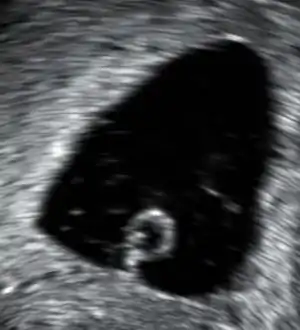Blighted ovum
| Anembryonic gestation | |
|---|---|
| Other names | Anembryonic gestation, anembryonic pregnancy |
 | |
| Transvaginal ultrasonography showing a gestational sac with a diameter of 28 mm, corresponding to a gestational age of approximately 7 weeks and 5 days. It contains a yolk sac (protruding from its lower part) but no embryo, even after scanning across all planes of the gestational sac, thus being diagnostic of an anembryonic gestation. | |
| Specialty | Obstetrics |
A blighted ovum is a pregnancy in which the embryo never develops or develops and is reabsorbed.[1] In a normal pregnancy, an embryo would be visible on an ultrasound by six weeks after the woman's last menstrual period. Anembryonic gestation is one of the causes of miscarriage of a pregnancy.[2][3][4]
A blighted ovum or anembryonic gestation is characterized by a normal-appearing gestational sac, but the absence of an embryo. It likely occurs as a result of early embryonic death with continued development of the trophoblast. When small, the sac cannot be distinguished from the early normal pregnancy, as there may be a yolk sac, though a fetal pole is not seen. For diagnosis, the sac must be of sufficient size that the absence of normal embryonic elements is established. The criteria depends on the type of ultrasound exam performed. A pregnancy is anembryonic if a transvaginal ultrasound reveals a sac with a mean gestational sac diameter (MGD) greater than 25 mm and no yolk sac, or an MGD >25 mm with no embryo. Transabdominal imaging without transvaginal scanning may be sufficient for diagnosing early pregnancy failure when an embryo whose crown–rump length is 15 mm or more has no visible cardiac activity.[5]
See also
References
- ↑ Kim Mackenzie-Morris. "What is a blighted ovum?". Babycentre.co.uk. Retrieved 19 December 2013.
- ↑ "Blighted Ovum: Symptoms, Causes and Prevention". American Pregnancy Association. 2012-04-26. Retrieved 2017-09-09.
- ↑ "Blighted ovum: What causes it?". Mayo Clinic. Retrieved 2017-09-09.
- ↑ Hoffman, Barbara (2012). Williams gynecology. New York: McGraw-Hill Medical. p. 171. ISBN 9780071716727.
- ↑ Campion, Edward W.; Doubilet, Peter M.; Benson, Carol B.; Bourne, Tom; Blaivas, Michael (10 October 2013). "Diagnostic Criteria for Nonviable Pregnancy Early in the First Trimester" (PDF). New England Journal of Medicine. 369 (15): 1443–1451. doi:10.1056/NEJMra1302417. PMID 24106937.
External links
- Blighted Ovum on WebMD
- Anembryonic pregnancy on Radiopaedia.org
- Johnson, MR; Riddle, AF; Sharma, V; Collins, WP; Nicolaides, KH; Grudzinskas, JG (January 1993). "Placental and ovarian hormones in anembryonic pregnancy". Human Reproduction (Oxford, England). 8 (1): 112–5. doi:10.1093/oxfordjournals.humrep.a137857. PMID 8458911.